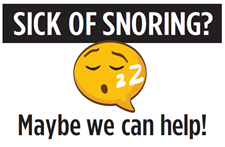What is snoring and how does it cause harm?
Snoring itself is just a noise made when air passes over soft tissues of the mouth and throat. However it impacts both the snorer and those around them.
It does this in two ways:
- Partner disturbance
- Self harm.
Partner disturbance:
Have you ever suffered a dig in the ribs? Broken sleep is almost as harmful as snoring itself. If you are given such a known indicator of snoring – its time to sort it out.
Self harm:
Self-harm means the snoring you do leads to harm. The key to understanding was first understood recently. When breathing drops or stops inflammation is created right through the whole body. This underlies most human disease processes. Some were well known to relate to snoring’s partner – Sleep Apnoea. Examples are Diabetes; high blood pressure, blood-vessel damage including high cholesterol, others are more recently been associated such as endometriosis and ovarian cyst disorder, still more are just being understood such as dementia.
So don’t kid yourself – it’s not just a noise. Snoring is found in nearly half (47%) of kids who have formal diagnosis of obstructive sleep apnoea. (Chervin/ Thoracic 2008). It appears half those who snore have some level of apnoea.
More disturbing is the May 2018 paper by the team headed by Leila Kheirandish-Gozal where they showed a predictable pattern of damage juveniles who snore. This damage was similar to that seen in Alzheimer’s.
What can you do? Try simple things. Wear a child’s school bag to bed so you don’t sleep on your back! Some sew tennis balls into sleep wear – cheap and simple. Others use nose strips. Oral and nasal appliances are probably the most used. Most sort-of work. You can try to find if there is a jaw position where you can almost not generate snoring. Try a pencil between back teeth and lie down flat. If you can find a helpful jaw position then you are a candidate for an anti-snore guard. There are no New Zealand guidelines so use the American ones- for mild to moderate sleep apnoea, the first treatment should be a mouth appliance. Don’t forget the nose! There are small devices that help nose breathing also.

